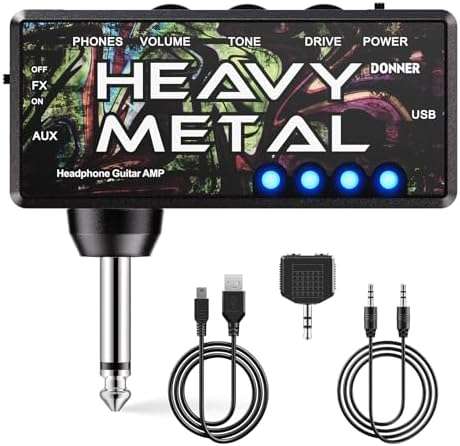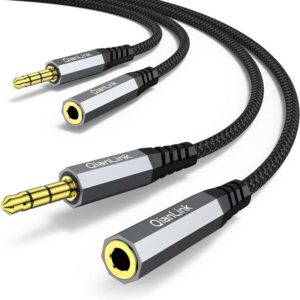Are you looking for a way to elevate your audio experience? Headphone amplifiers might be just what you need.
Headphone amplifiers are designed to boost your headphones’ sound quality and power, offering a richer and more detailed listening experience. But do they really make a difference in your audio journey?
Headphone amplifiers improve the sound quality by driving headphones to their full potential, ensuring clearer highs and deeper lows. Audiophiles, musicians, and even casual listeners can benefit from these devices.
Whether you’re using high-impedance headphones or simply want to improve the audio performance, a good headphone amplifier is essential.
Want to know how headphone amplifiers can enhance your sound quality? Keep reading as we explore the top reasons why audiophiles swear by them, and how to choose the best one for your needs. Let’s dive deeper into the world of headphone amplifiers and discover the true power of sound!
Decoding Headphone Amplifiers: The Basics
Understanding Headphone Amplifiers: Unraveling the Mystery
A headphone amplifier is an electronic device that strengthens audio signals from sources like smartphones, computers, or DACs. It provides the necessary power to drive headphones, enhancing sound clarity and volume.
While most devices come with built-in headphone amplification, standalone amplifiers offer superior performance, catering to discerning listeners in pursuit of enhanced sound quality.
How Headphone Amplifiers Work: Behind the Scenes
The fundamental principle behind headphone amplifiers revolves around signal amplification. As audio signals pass through the amplifier, they undergo voltage or current amplification, resulting in a more robust output capable of driving headphones with varying impedance levels.
This amplification process aids in mitigating distortion, enhancing dynamics, and unlocking the full potential of high-fidelity audio equipment.
The Impedance Factor: Matching Power with Precision
Impedance plays a pivotal role in headphone amplifier compatibility and performance. Headphones come with various impedance ratings, typically ranging from a few ohms to several hundred ohms.
An effective headphone amplifier must match the impedance of the headphones to deliver optimal sound quality and power output. Mismatched impedance can lead to subpar audio performance, including distortion and insufficient volume levels.
Why Headphone Amplifiers Matter: Elevating Your Listening Experience
Headphone amplifiers are indispensable for audiophiles and music enthusiasts who crave the utmost sound quality from their headphones. They enhance the overall listening experience by providing better dynamics, increased detail, and tighter bass response.

Credit: www.nytimes.com
Advantages of Using Headphone Amplifiers
Enhanced Audio Quality: Unleashing Sonic Brilliance
Headphone amplifiers excel at enhancing audio quality. They deliver cleaner, more powerful signals, ensuring a richer listening experience for all users. These devices breathe new life into music by offering ample power and clean amplification, delivering richer, more detailed soundscapes with improved clarity and dynamics.
Improved Soundstage and Imaging: A Journey into Spatial Realms
Another advantage of headphone amplifiers is their capacity to expand the soundstage and enhance imaging. With precise amplification and signal processing, these devices create a more immersive listening environment, allowing you to discern subtle nuances and spatial cues within the music.
Driving High-Impedance Headphones: Powering Performance
High-impedance headphones, renowned for their superior sound quality and detail retrieval, often require substantial power to drive effectively. Headphone amplifiers excel in this regard, providing the necessary voltage and current to unleash the full potential of high-impedance headphones.
Types of Headphone Amplifiers
Portable Amplifiers: Sound on the Go
Portable amplifiers are compact and lightweight devices designed to deliver enhanced audio performance on the move. Ideal for use with smartphones, laptops, and portable music players, these amplifiers offer convenience without compromising sound quality.
Desktop Amplifiers: Powerhouse Performance
Desktop amplifiers are larger and more powerful than their portable counterparts, making them perfect for home or studio use. With their robust construction and high-quality components, desktop amplifiers deliver superior sound performance and greater flexibility in driving a wide range of headphones.
Solid-State Amplifiers: Precision and Reliability
Solid-state headphone amplifiers utilize transistors and integrated circuits to amplify audio signals. Known for their reliability, low distortion, and consistent performance, solid-state amplifiers offer a clean and transparent sound signature, ideal for critical listening and studio applications.
Tube Amplifiers: Vintage Vibes
Tube headphone amplifiers, also known as valve amplifiers, employ vacuum tubes to amplify audio signals. Renowned for their warm, euphonic sound signature and harmonic richness, tube amplifiers impart a distinct sonic character to the music, reminiscent of vintage audio equipment.
Hybrid Amplifiers: The Best of Both Worlds
Hybrid headphone amplifiers combine the strengths of both solid-state and tube components into a single device. By leveraging the advantages of each technology, hybrid amplifiers offer a versatile sonic palette, appealing to a wide range of audiophiles and enthusiasts.
Key Considerations When Choosing Headphone Amplifiers
Impedance Matching: Finding Harmony
When selecting a headphone amplifier, impedance matching is crucial to ensure optimal performance and compatibility with your headphones.
Power Output: Driving Dynamics
The power output of a headphone amplifier directly impacts its ability to drive headphones effectively, especially those with higher impedance or power requirements.
Amplifier Topology: Choosing Your Sound Signature
Consider the amplifier topology and circuit design when evaluating headphone amplifiers, as they contribute to the overall sound signature.
Signal-to-Noise Ratio: Clarity Counts
A high signal-to-noise ratio (SNR) is essential for minimizing background noise and preserving the clarity of the audio signal. Look for amplifiers with low noise levels and high SNR ratings to ensure clean, distortion-free sound reproduction.
Form Factor and Portability: Mobility Matters
Consider the size, weight, and portability of the amplifier, especially if you plan to use it on the go. Portable amplifiers should be lightweight, compact, and durable, with long battery life for extended listening sessions away from home.
Headphone Amplifiers: Beyond Music
Gaming and Multimedia: Immersive Experiences
In addition to enhancing music playback, headphone amplifiers elevate gaming and multimedia experiences to new heights by improving spatial awareness, detail retrieval, and dynamic range.
Audio Production and Mixing: Professional Tools
For audio professionals and enthusiasts involved in production, mixing, and mastering, headphone amplifiers serve as indispensable tools for critical listening and sound evaluation.

Credit: www.amazon.com
Top Features to Look for in Headphone Amplifiers
Balanced vs. Unbalanced Outputs: Achieving Balance
Some headphone amplifiers offer balanced headphone outputs, which can provide improved channel separation and reduced crosstalk for a more spacious and detailed soundstage. However, balanced headphones and cables are required to take full advantage of this feature.
Gain Control: Setting the Stage
Gain control enables precise adjustment of the amplifier’s output level to align with both the sensitivity of your headphones and the volume from your audio source. It helps prevent distortion and ensures that you can achieve your desired listening level without overdriving the amplifier.
DAC Integration: Digital Precision
Many modern headphone amplifiers include a built-in digital-to-analog converter (DAC), allowing you to bypass the DAC in your audio source and enjoy high-resolution audio playback directly from your computer or mobile device.
Look for amplifiers with support for popular audio formats like FLAC, ALAC, and DSD.
Multiple Inputs: Versatile Connectivity
Having multiple input options, such as analog RCA, digital coaxial, and USB, gives you greater flexibility when connecting various audio sources to your amplifier. It allows you to switch between different devices seamlessly and ensures compatibility with a wide range of audio equipment.
Popular Headphone Amplifier Brands and Models
Headphone amplifiers play a crucial role in enhancing audio quality, providing the necessary power and fidelity for a superior listening experience. Below is an overview of some notable headphone amplifier brands and their popular models:
1. Sennheiser HDV 820: High-End Excellence
The Sennheiser HDV 820 is a premium desktop headphone amplifier renowned for its exceptional sound quality and robust feature set. Key specifications include:
- Design: Sleek anodized black finish with white LED lights, complementing high-end headphones like the Sennheiser HD 800 S.
- Digital-to-Analog Converter (DAC): Equipped with an ESS SABRE32 DAC supporting resolutions up to 32-bit/384 kHz and DSD256 files up to 12.3 MHz.
- Inputs: Offers optical, coaxial, and USB digital inputs, along with balanced (XLR) and unbalanced (RCA) analog inputs.
- Outputs: Features a variety of headphone outputs, including 3-pin XLR, 4-pin XLR, 1/4″ (6.3 mm), and 4.4 mm Pentaconn sockets.
- Performance: Frequency response ranges from <10 Hz to >100 kHz, with a total harmonic distortion (THD) of <0.001% and a dynamic range exceeding 115 dB at a 600 Ω load.
- Dimensions and Weight: Approximately 224 x 44 x 306 mm and 2.25 kg.
This amplifier is designed to deliver an unparalleled listening experience for discerning audiophiles.
2. Schiit Audio Magni 3+: Affordable Performance
The Schiit Audio Magni 3+ is a compact and cost-effective headphone amplifier that doesn’t compromise on performance. Notable features include:
- Design: Minimalist and sturdy build suitable for desktop use.
- Amplification: Utilizes a discrete gain stage to provide low distortion and high output power, ensuring transparent and accurate sound reproduction.
- Inputs and Outputs: Includes RCA inputs and both 1/4″ (6.3 mm) and RCA preamp outputs for versatility.
The Magni 3+ is an excellent choice for budget-conscious audiophiles seeking high-quality amplification.
3. FiiO E10K: Portable Powerhouse
The FiiO E10K is a popular portable headphone amplifier and DAC combination, offering impressive performance at an affordable price point. Key specifications include:
- DAC: Incorporates a PCM5102 DAC chip capable of handling PCM files up to 24-bit/96 kHz, improving audio quality with a linear internal filter and reduced delay.
- Amplification: Features an LMH6643 op-amp designed for superior transient response and driving power.
- Design: Compact and sturdy with a brushed aluminum shell, ideal for portable use.
- Inputs and Outputs: Connects via Micro USB and includes a front-panel 1/8″ (3.5 mm) headphone output, rear-panel 1/8″ line output, and coaxial digital output.
- Additional Features: Offers a selectable bass boost and low-pass filter, both optimized for a low-noise floor.
The E10K is well-suited for users seeking enhanced audio performance on the go.
4. iFi Audio nano iDSD Black Label: Compact Versatility
The iFi Audio nano iDSD Black Label is a portable DAC and headphone amplifier known for its versatility and high-resolution audio support. Key features include:
- DAC: Supports PCM files up to 32-bit/384 kHz and DSD256, catering to high-resolution audio enthusiasts.
- Amplification: Provides sufficient power to drive a wide range of headphones, including those with higher impedance.
- Design: Compact and lightweight, making it ideal for portable use.
- Inputs and Outputs: Features a USB input for digital audio and a 1/8″ (3.5 mm) headphone output.
- Additional Features: Includes a selectable filter for sound customization and a built-in battery for mobile use.
The nano iDSD Black Label offers a balance of portability and high-quality audio performance.
5. AudioQuest DragonFly Cobalt: USB DAC and Headphone Amplifier
The AudioQuest DragonFly Cobalt is a compact USB DAC and headphone amplifier that enhances audio quality for laptops and mobile devices. Notable features include:
- DAC: Utilizes an ESS ES9038Q2M DAC chip, supporting high-resolution audio playback.
- Amplification: Provides ample power to drive most headphones efficiently.
- Design: Ultra-compact form factor resembling a USB flash drive, with a durable build.
- Inputs and Outputs: Connects via USB-A and includes a 1/8″ (3.5 mm) headphone output.
- Compatibility: Works seamlessly with computers and mobile devices using appropriate adapters.
The DragonFly Cobalt is ideal for users seeking a simple yet effective solution to improve their portable audio experience.
6. Chord Electronics Mojo 2: Portable High-Fidelity
The Chord Electronics Mojo 2 is a high-fidelity portable DAC and headphone amplifier known for its exceptional sound quality and advanced features. Key aspects include:
- DAC: Employs Chord’s proprietary FPGA technology, supporting PCM up to 32-bit/768 kHz and DSD512.
- Amplification: Delivers high output power capable of driving demanding headphones while maintaining clarity and precision.
- Design: Compact yet sturdy aluminum chassis with distinctive spherical control buttons.
- Inputs and Outputs: Features USB-C, micro-USB, optical, and 3.5mm coaxial inputs, along with dual 3.5mm headphone outputs for shared listening.
- Additional Features: Introduces UHD DSP (digital signal processing) for sound customization, crossfeed mode for natural listening, and improved battery life.
The Mojo 2 is an excellent choice for audiophiles who want a portable yet powerful amplifier for high-fidelity audio.
How to Properly Set Up and Use Headphone Amplifiers
Connecting to Audio Sources: Ensuring Connectivity
To connect your headphone amplifier to your audio source, use high-quality audio cables with gold-plated connectors to minimize signal loss and interference. If your amplifier has multiple input options, choose the one that best suits your audio source, whether it’s analog, digital, or USB.
Adjusting Volume and Gain Settings: Finding Balance
Start by setting the volume and gain controls on your amplifier to their lowest levels before powering on your audio source. Gradually increase the volume until you reach a comfortable listening level, taking care not to exceed the amplifier’s maximum output power or risk damaging your headphones.
Troubleshooting Common Issues: Addressing Concerns
If you encounter any issues with your headphone amplifier, such as noise, distortion, or lack of sound, first check the connections and ensure that all cables are securely plugged in. If the problem persists, consult the user manual for troubleshooting tips or contact the manufacturer for further assistance.
Conclusion
In conclusion, headphone amplifiers play a crucial role in enhancing sound quality and elevating the listening experience to new heights. Whether you prioritize pristine audio fidelity, immersive gaming experiences, or studio-grade monitoring capabilities, there’s a headphone amplifier tailored to meet your needs.
By understanding the fundamentals of amplifier technology and considering key factors such as impedance matching and power output, you can embark on a journey of sonic discovery and immersion unlike any other. Choose your headphone amplifier wisely, and let the music take you on an unforgettable auditory adventure.
FAQs about Headphone Amplifiers
What is the purpose of a headphone amplifier?
A headphone amplifier boosts the audio signal from your audio source to provide more power and clarity when driving headphones, resulting in improved sound quality and a better overall listening experience.
Do I need a headphone amplifier if my headphones are already loud?
Even if your headphones can reach high volume levels without an amplifier, they may benefit from improved dynamics, detail, and control with a dedicated headphone amplifier, especially if they have high impedance or need more power to operate.
Can a headphone amplifier damage my headphones?
While it’s unlikely that a properly designed and operated headphone amplifier will damage your headphones, it’s essential to use caution when adjusting volume and gain settings to avoid overdriving the amplifier and causing distortion or clipping.
Are there any disadvantages to using headphone amplifiers?
Some headphone amplifiers may introduce additional noise or coloration to the audio signal, particularly if they’re poorly designed or lack proper shielding against electromagnetic interference. However, high-quality amplifiers should maintain a transparent and neutral sound signature.
How much should I expect to spend on quality headphone amplifiers?
The cost of a headphone amplifier can vary widely depending on its features, build quality, and brand reputation. Entry-level models start at around $100, while high-end models can cost several thousand dollars or more, with prices influenced by factors such as materials, design, and performance.
Can A Portable Headphone Amp Provide Better Sound?
Yes, a dedicated portable headphone amplifier can provide better sound quality than the built-in amplifier in your portable device.
Will A Headphone Amplifier Enhance Bass?
Yes, a headphone amplifier can enhance bass and overall sound quality, but it depends on the amplifier’s specifications and your headphones’ impedance.

A passionate tech blogger and the founder of Best Tech View, a dynamic platform dedicated to all things technology. With a keen interest in the tech, Ahmad strives to provide insightful and engaging content on the latest tech trends, and breakthroughs.



